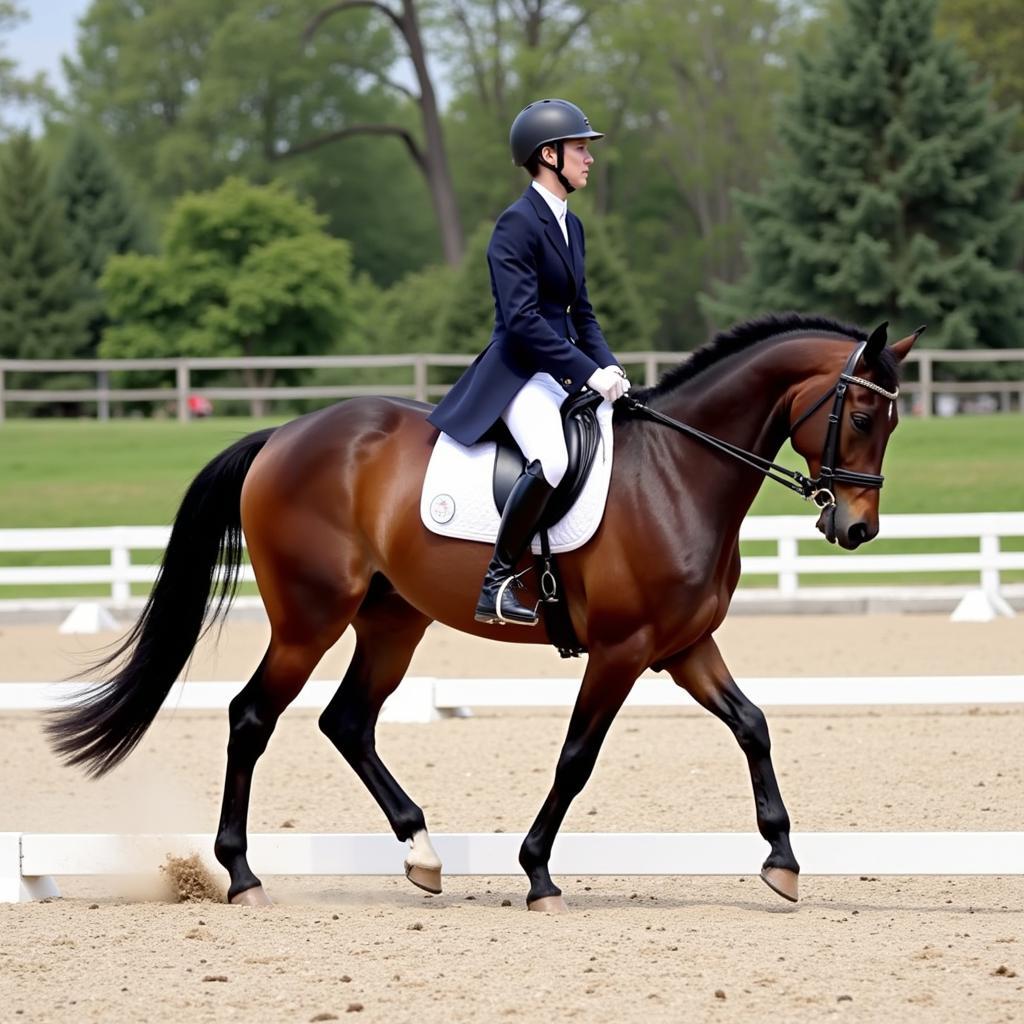The term “Goose Rump Horse” describes a specific equine conformation, referring to a sloping croup. This article dives deep into the goose rump horse, exploring its characteristics, potential implications for performance, and overall management considerations. We’ll cover everything you need to know about this unique conformation trait.
What Exactly is a Goose Rump?
A goose rump is characterized by a croup that slopes downward from the point of the hip to the tailhead. This distinct sloping appearance is often likened to the shape of a goose’s rear end, hence the name. While it’s primarily an aesthetic observation, a goose rump can sometimes influence a horse’s biomechanics and athletic potential.
This conformation doesn’t necessarily indicate poor health or unsoundness, but it’s important to understand how it might affect your horse’s movement and overall performance. Understanding the nuances of the goose rump can equip owners with the knowledge needed to manage their horses effectively.
Identifying a Goose Rump Horse: Key Characteristics
Recognizing a goose rump is fairly straightforward. The defining feature is the visible slope of the croup. Here’s what to look for:
-
Sloping Croup: The most obvious indicator. Observe the horse from the side. The line from the point of the hip to the tailhead will slant downwards.
-
Low-Set Tail: Often accompanies a goose rump. The tail appears to be set lower on the hindquarters, seemingly emerging from the sloping croup.
-
Weak Topline: In some cases, a goose rump can be associated with a weaker topline, but this is not always the case.
It’s important to note that the degree of slope can vary, ranging from subtle to quite pronounced.
Does a Goose Rump Impact Performance?
The impact of a goose rump on performance is a topic of ongoing discussion. While some believe it significantly hinders athleticism, others argue its effects are minimal. Here’s a balanced perspective:
- Potential Challenges: A sloping croup can potentially weaken the engagement of the hindquarters, affecting power and impulsion. It can also influence the horse’s ability to collect and maintain balance, especially in demanding disciplines like jumping or dressage.
- Not Always a Limitation: Many horses with goose rumps perform exceptionally well across various disciplines. Proper training and conditioning can help mitigate any potential drawbacks.
- Discipline-Specific Considerations: The impact of a goose rump can vary depending on the discipline. In some disciplines, such as western pleasure, where a low-set tail and smooth gait are desired, a mild goose rump might not be considered a significant disadvantage.
It’s crucial to assess each horse individually and consider the degree of the slope. A slightly sloping croup may have minimal impact, while a severely sloping croup could pose more significant challenges.
Management Considerations for Goose Rump Horses
Managing a horse with a goose rump often involves focusing on strengthening the hindquarters and maintaining overall fitness.
- Targeted Exercises: Exercises like hill work, transitions, and collected work can help develop the hindquarter muscles.
- Proper Saddle Fit: A well-fitting saddle is crucial for any horse, but especially important for those with a goose rump. An improperly fitted saddle can exacerbate any existing biomechanical imbalances.
- Regular Veterinary Checkups: Routine veterinary care can help identify and address any potential issues related to the conformation.
 Horse with Goose Rump Performing Dressage Remember, proactive management and appropriate training can help a horse with a goose rump reach its full potential.
Horse with Goose Rump Performing Dressage Remember, proactive management and appropriate training can help a horse with a goose rump reach its full potential.
Conclusion
The “goose rump horse” conformation, while visually distinctive, doesn’t necessarily define a horse’s athletic capabilities. By understanding its characteristics and potential implications, owners can make informed decisions about training, management, and overall care. With the right approach, a goose rump horse can thrive and excel in a variety of disciplines.
FAQ
- Is a goose rump a genetic trait? While conformation is influenced by genetics, it’s not solely determined by it. Environmental factors can also play a role.
- Can a goose rump be corrected? No, it’s a skeletal characteristic and cannot be changed.
- Are horses with goose rumps more prone to injuries? Not necessarily, but they might be at a slightly higher risk of certain hind-end issues if not managed properly.
- Should I avoid buying a horse with a goose rump? Not necessarily. Consider the individual horse, its overall conformation, and the intended use.
- What disciplines are best suited for goose rump horses? There’s no one-size-fits-all answer. Many horses with goose rumps excel in various disciplines with appropriate training.
- How can I tell if a saddle fits my goose rump horse properly? Consult with a qualified saddle fitter for expert advice.
- Are there any specific exercises I should avoid with a goose rump horse? Avoid exercises that put excessive strain on the hindquarters, especially before the horse is properly conditioned.
Need assistance? Contact us at Phone Number: 0772127271, Email: [email protected], or visit our address: QGM2+WX2, Vị Trung, Vị Thuỷ, Hậu Giang, Vietnam. Our customer service team is available 24/7.